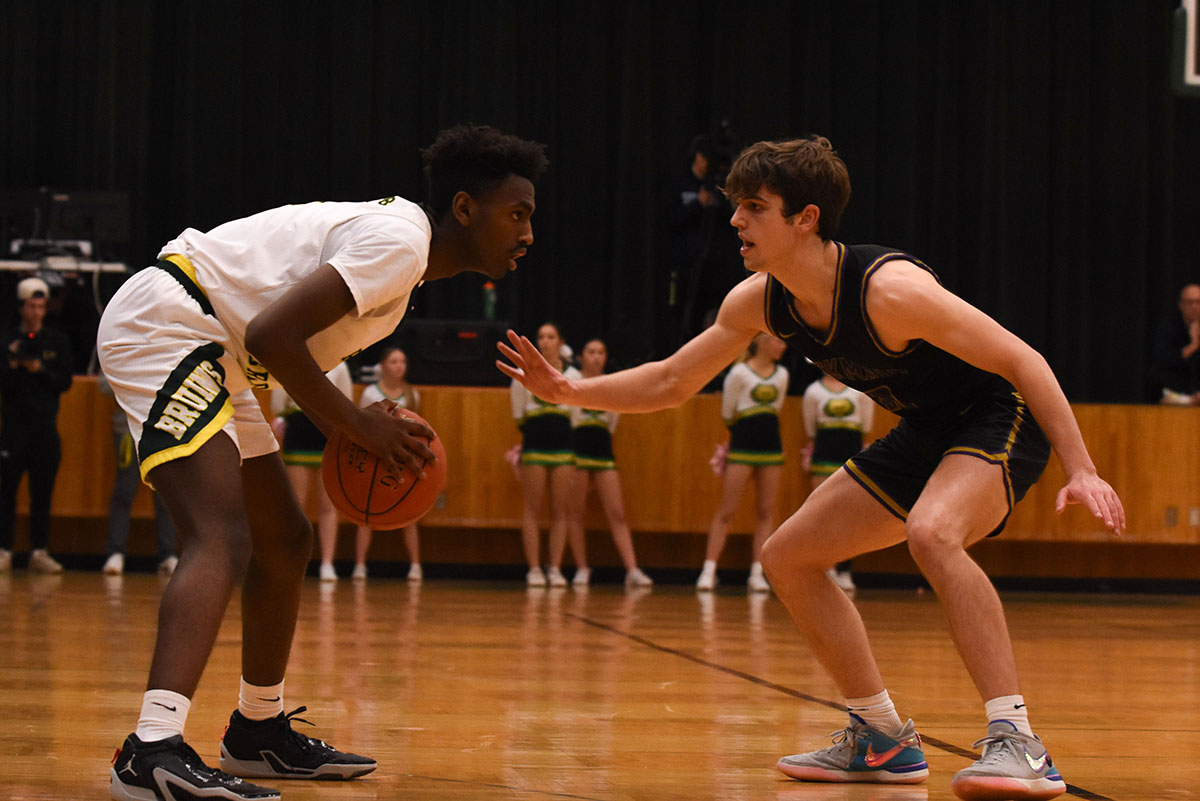
[heading]Popularity of head injuries causes scare, initiates talk of new forms of protection[/heading] There was a time, not that long ago, when football was a sport of unrestrained violence. Penalties were scarce and big hits were common in games. Players constantly hit with their helmets for the jarring collisions produced and the elevated chance to knock the ball loose. It was a rough game in which leaving the field with an injury was perceived as weakness. Exiting the game after a hit to the head was all but unthinkable.
Nowadays, everything has changed. Penalties exist banning head on collisions, targeting players with the helmet and aiming above the shoulders in general. Hard hits to the head, once considered part of the game, now prompt thorough evaluation from team trainers searching for signs of a concussion, the injury that has risen from obscurity and grabbed full attention of the sports world in the last few years.
Described as a ‘bruise to the brain’ by RBHS trainer Greg Nagel, concussions have become the most prominent injury in sports today as more research emerges revealing the scarring and permanent side effects caused by the injury. These side effects have proven to shorten players careers.
The National Football League, the biggest professional sports league in North America, has found itself in the midst of a massive concussion problem in recent years. As parents are made aware of the effects of concussions, high school athletes now have to fill out a concussion form. that used to wasn’t required. Concussions are no secret anymore, and they are revolutionizing the perception of head injuries forever.
In 1994 NFL commissioner Paul Tagliabue approved the organization of an NFL sponsored committee to research the effects of concussions and report their findings. The committee was not without controversy as the head of the team, Dr. Elliot Pellman, was not a neurologist and possessed limited knowledge of head injuries.
At the conclusion of the investigation the committee ruled that there was no long-term damage associated with concussions and that they were not to be considered a serious injury, despite opposing investigations that concluded that concussions caused long-term brain injury.
Today the NFL concedes concussions are a significant problem. Subsequently the league has taken significant steps to reduce the number of head injuries suffered. This includes moving kickoffs up, enforcing rules about targeting with the helmet, and not allowing a player to return to the game after suffering a concussion.
Despite it’s best efforts at damage control, the NFL’s refusal to acknowledge the danger of concussions previously has landed it in the crossfire of countless lawsuits issued by former players with long-term brain damage, delivered a crushing blow to its once sterling reputation, and even put the future of the sport in it’s current state in question.The impact concussions have made on the NFL has trickled down to collegiate, high school, and even to little league sports. Nagel says he does not necessarily see any more concussions than he used to before. However, the awareness and anxiety that goes along with them have elevated.
“Concussions are dangerous because if you don’t handle them right they can become a huge problem,” Nagel said. “I think awareness has increased recently, and I expect that, as equipment and technology improve, concussions will become less of a threat.”
While concussions may sound like a scary prospect to most, some of the most at risk people don’t appear too concerned. A study by the Cincinnati Children’s Hospital Medical Center reported that 50% of high school football players would alert their coach if they suffered a head injury rather than holding off in hopes of returning sooner to practice and to competition.
“I’m not really worried about concussions,” junior football player Love Patel said. “When I signed up, I knew I was joining a contact sport and concussions happen. It doesn’t happen often, and when it does it’s not severe.”
While the overall generalization is that football players are invincible the fact of the matter is that the risk of reciting a concussion very probable. Just this past week starting quarterback Logan Twehous suffered an injury in a loss to Jefferson City, which medical staff later diagnosed as a concussion. Twehous will likely be out this week in a state playoff rematch against the Jays.
Nagel says most of the concussion victims he sees come from three sports at RBHS: football, wrestling and cheerleading. Combined, high school athletes suffer an estimated 136,000 to 300,000 concussions per year in the United States.
“It’s definitely a pretty high number,” Nagel said. “The ultimate goal is obviously to reduce that number but there’s only so much you can do.”
Long term effects of concussions are known to increase the risks of contracting various illnesses, including dementia, Parkinson’s disease and depression. This is caused by the massive amount of brain trauma suffered from sustaining multiple concussions throughout ones sports career.
“We only have one brain, so that’s what makes this type of injury so important,” Nagel said. “It affects the central nervous system and really manifests itself in bizarre ways. It can lead to all sorts of problems such as memory loss, balance issues and difficulty performing regular functions.”
While concussions are mainly associated with athletics, any time a person hits their head doing anything they are at risk, as the brain is moved around unprotected. Senior Breta Phillips found out this startling fact a year ago. Phillips was running through Rock Bridge State Park last November when she slipped and fell into the Devil’s Icebox cave. Phillips was airlifted to the hospital and was treated for numerous injuries. One of them was a severe concussion which has left lingering effects.
“I lost a lot of coordination,” Phillips said. “I now wear reading glasses even though I had perfect vision before the fall. I suffered bleeding of the brain and there was heavy memory loss. A lot of the time things would get hazy. Concussions also affect your hormone levels so I also had some mood swings.”
Nagel said he treats concussions with total brain rest and eliminates stressors such as bright lights, loud noises, and even spicy foods. Phillips said she received several treatments including rehab.
“I received rehab for the fall, which was primarily physical,” Phillips said. “As for the concussions, I underwent a lot of testing to make sure I was functioning mentally. If I ever get another concussion I can never play sports again.”
While circumstances such as Phillips’ are rare, she is an example of the long term effects concussions have the ability of having on all of us. Nagel believes that, in general, the prognosis on concussions has a hopeful outlook. Nagel also speaks of a time, hopefully in the near future when dangerous head injuries, such as concussions and other trauma, will fade to black.
“Concussions are dangerous among the uneducated,” Nagel said. “But any publicity right now is good publicity and I feel like the situation can only improve. Concussions will never completely go away. But they are definitely trending downward, and that’s a very good sign.”
By Josh Ripley














































































Ronel • Nov 19, 2013 at 7:34 am
Concussions can be a very serious and dangerous problem if they are not treated or diagnosed right away. I’m glad that the awareness of this problem is arising.
Jenna Liu • Nov 10, 2013 at 5:04 pm
Concussion are especially dangerous for young adults, and can lead to chronic issues later on in life. I’m glad that people are becoming more aware of this problem.
Grace V • Nov 6, 2013 at 6:36 pm
It’s terrible that concussions affect so many players, but it’s great that people have raised awareness so it can be less of a common problem